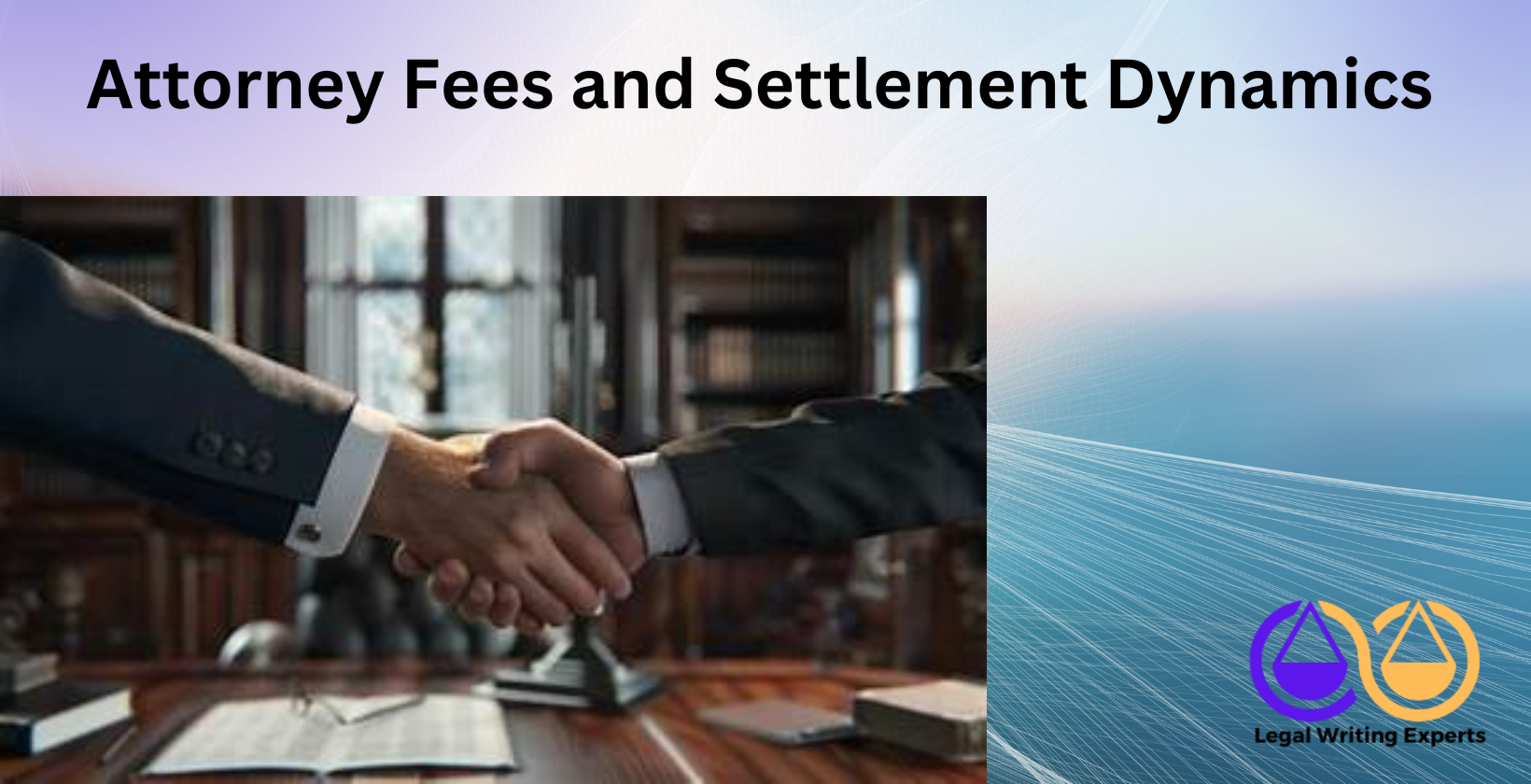Attorney Fees and Settlement Dynamics
Written by
Jessica E
May 22, 2025 · 8 min read

This article explores the essentials of attorney fees and settlement dynamics, offering insights into their structure, documentation, and professional support. It covers how fees influence settlements, effective writing strategies for legal documents, and where to find skilled legal writers to create such content.
What Are Attorney Fees and Settlement Dynamics?
Attorney fees and settlement dynamics refer to the costs charged by lawyers and the negotiation processes that resolve legal disputes. Attorney fees vary by structure, with 33% of U.S. attorneys using contingency fees for personal injury cases, according to a 2023 American Bar Association study. Hourly rates, averaging $200-$400, dominate corporate law. Flat fees, common for wills, range from $500-$1,500. Settlement dynamics involve strategies to reach agreements, influenced by fee arrangements. Contingency fees align attorney and client interests but may pressure quicker settlements. Harvard Law School’s 2022 negotiation research notes that 85% of civil cases settle before trial, driven by cost-benefit analyses. Examples include personal injury settlements averaging $50,000 and employment disputes at $40,000.
How to Write About Attorney Fees and Settlement Dynamics?
Writing about attorney fees and settlement dynamics requires clarity, precision, and legal accuracy to create effective lawyer papers.
- Use clear language. Legal documents must avoid ambiguity, as 70% of litigation disputes stem from unclear contract terms, per a 2024 Stanford Law study. For example, specify “contingency fee of 30%” instead of “reasonable fee.”
- Structure content logically. Organize documents with headings like “Fee Structure” or “Settlement Terms” to enhance readability. Yale Law’s 2023 drafting guide reports that structured contracts reduce disputes by 40%.
- Include specific examples. Detail fee types, such as hourly rates ($250/hour) or flat fees ($1,000 for a will), to clarify expectations.
- Address legal implications. Explain how fees impact settlements, like contingency fees encouraging faster resolutions. A 2022 University of Chicago study found contingency-based cases settle 20% faster than hourly ones.
- Ensure compliance. Verify documents meet state laws, as non-compliant contracts are voided in 15% of cases, per a 2024 NYU Law report.
These steps ensure legal drafting services produce accurate, client-focused content.
Where to Hire a Legal Writer to Draft Content on Attorney Fees and Settlement Dynamics?
Legal writing experts provide the best solution for drafting content on attorney fees and settlement dynamics. These professionals, skilled in creating legal documents, offer specialized services through legal document drafting services and freelance legal research platforms, ensuring precise and compliant lawyer legal documents tailored to client needs.
How to File a Claim Involving Attorney Fees and Settlements?
Filing a claim involving attorney fees and settlements requires a structured approach to ensure legal accuracy and compliance.
- Consult an attorney to assess the claim. A 2023 American Bar Association report indicates that 60% of successful claims start with a professional evaluation to confirm validity. For instance, an attorney can review fee disputes in a $100,000 settlement case.
- Collect relevant evidence. Gather documents like fee agreements or billing records, such as a contract specifying a 30% contingency fee. A 2024 University of Texas Law study notes that 25% of claims fail due to insufficient evidence.
- File the claim with the correct court. Ensure compliance with local rules, as procedural errors lead to 25% of dismissals, per the same 2024 study. Include details of attorney fees and settlement terms in the filing.
- Engage in settlement negotiations. A 2022 Harvard Law School study shows 80% of fee-related disputes resolve out of court, often through mediated agreements. For example, negotiate a disputed $10,000 attorney fee to avoid litigation.
- Verify compliance with state laws. Non-compliant filings are voided in 15% of cases, according to a 2024 NYU Law report, so confirm jurisdictional requirements before submission.
These steps, supported by legal document drafting services, ensure a precise and effective filing process.
What Are Common Fee Structures in Legal Settlements?
Common fee structures in legal settlements include hourly rates, contingency fees, and flat fees. Hourly rates, averaging $200-$400, are used by 45% of attorneys, particularly in corporate and family law, per a 2023 American Bar Association survey. Contingency fees, ranging from 25%-40%, are common in personal injury cases, where attorneys earn a percentage of the settlement, such as $30,000 from a $100,000 award at 30%. Flat fees, typically $500-$2,000, apply to routine tasks like drafting wills. A 2024 NYU Law study finds that 20% of settlements use hybrid models, combining hourly and contingency fees, to balance risk and cost. These structures, often outlined in lawyer legal documents, directly influence settlement strategies.
How Do Contingency Fees Affect Settlement Outcomes?
Contingency fees impact settlement outcomes by aligning attorney and client goals but can influence case strategy.
- Encourage faster settlements. A 2022 University of Chicago study shows contingency-based cases settle 20% faster than hourly ones, as attorneys prioritize efficiency. For example, a $50,000 case with a 33% fee nets $16,500.
- Reduce upfront client costs. Clients pay nothing unless they win, making legal services accessible. A 2023 Stanford Law report notes 60% of personal injury clients rely on this model.
- May lead to smaller settlements. The same Stanford report finds 15% of contingency cases settle for less to avoid trials, such as accepting $40,000 instead of pursuing $60,000.
- Influence case selection. Attorneys may avoid complex cases with low win probabilities, as 10% of contingency cases are declined for risk, per a 2024 Yale Law study.
- Require clear agreements. Precise legal drafts prevent disputes, as 20% of fee conflicts arise from vague terms, per a 2023 American Bar Association survey.
These effects highlight the role of legal document drafting services in clarifying terms.
What Factors Influence Attorney Fee Negotiations in Settlements?
Several factors shape attorney fee negotiations in settlements, impacting costs and outcomes.
- Case complexity. Complex cases like medical malpractice increase fees by 35%, per a 2024 Yale Law study, due to higher time and expertise demands. For example, a malpractice case may incur a 40% contingency fee.
- Client financial capacity. A 2023 American Bar Association survey shows 30% of clients negotiate lower rates, such as reducing a 33% contingency fee to 25%.
- Attorney experience. Experienced attorneys charge 20% more but secure 25% higher settlements, per a 2022 Harvard Law report. For instance, a senior lawyer may charge $400/hour versus $200/hour for a junior one.
- Market standards. Urban areas have hourly rates of $300-$500, while rural areas range from $150-$250, per a 2024 NYU Law study, affecting negotiation baselines.
- Settlement size. Larger settlements allow flexible fees, such as 25% for a $200,000 award versus 33% for a $50,000 one, per the same NYU study.
These factors, documented through legal writing services, guide effective fee agreements.
How Much Do Attorneys Typically Charge for Settlement Cases?
Attorneys typically charge for settlement cases using hourly rates, contingency fees, or flat fees, with costs varying by case type and region. Hourly rates range from $200 to $400, with 45% of attorneys using this model for settlements, per a 2023 American Bar Association survey. Contingency fees, common in personal injury cases, average 25%-40%, meaning a $100,000 settlement yields $25,000-$40,000 for the attorney. Flat fees, used for simpler cases like contract disputes, range from $1,000-$5,000. A 2024 NYU Law study notes urban attorneys charge 20% more than rural ones, with rates like $350/hour in cities versus $200/hour in smaller towns. For example, a personal injury settlement in California may incur a 33% contingency fee, while a commercial dispute in Texas might cost $300/hour. Legal document drafting services ensure these fees are clearly outlined to avoid disputes.
What Is the Role of Settlement Agreements in Fee Disputes?
Settlement agreements play a critical role in preventing and resolving fee disputes by clearly defining attorney compensation. These lawyer legal documents specify fee structures, such as a 30% contingency fee or $250/hour, reducing ambiguity. A 2023 Stanford Law study finds that 70% of fee disputes arise from unclear contract terms, but precise agreements cut disputes by 50%. For example, an agreement stating “attorney receives 25% of the $50,000 settlement” avoids misinterpretation. Settlement agreements also outline payment schedules, like disbursing fees post-settlement, ensuring transparency. A 2022 Harvard Law report notes that 85% of mediated settlements with detailed agreements resolve fee conflicts out of court. Legal writing services are essential for drafting these binding documents.
How Long Does It Take to Resolve a Settlement with Attorney Fees?
Resolving a settlement with attorney fees typically takes 3 months to 2 years, depending on case complexity and fee structure.
- Assess case timeline. Simple personal injury cases settle in 3-6 months, per a 2023 American Bar Association report, while complex commercial disputes take 1-2 years.
- Consider fee structure impact. Contingency fee cases resolve 20% faster than hourly ones, as attorneys prioritize efficiency, per a 2022 University of Chicago study. For example, a $50,000 injury case may settle in 4 months.
- Factor in negotiation duration. A 2024 Yale Law study shows 80% of settlements conclude after 2-4 negotiation rounds, each lasting 1-2 weeks.
- Account for court delays. If litigation is needed, delays add 6-12 months, per a 2023 NYU Law report, due to court scheduling.
- Ensure proper documentation. Legal document drafting services expedite resolutions by clarifying terms, reducing disputes by 30%, per a 2024 Stanford Law study.
These factors shape the timeline for settlement resolutions.
What Are the Tax Implications of Attorney Fees in Settlements?
Attorney fees in settlements have specific tax implications, depending on the case type and fee structure. Contingency fees are taxable as part of the settlement award, per IRS guidelines. For example, in a $100,000 personal injury settlement with a 33% contingency fee, the client reports the full $100,000 as income, though personal injury awards are often tax-exempt. In non-exempt cases, like employment disputes, the $33,000 fee is deductible, per a 2023 University of Texas Law study, reducing taxable income. Hourly fees, paid separately, are deductible in business-related settlements but not personal ones, per a 2024 NYU Law report. A 2022 Harvard Law study notes 60% of clients misreport fees due to unclear legal drafts. Online legal document review ensures compliance with tax laws, minimizing errors.
How Can Clients Minimize Attorney Fees in Settlement Cases?
Clients can minimize attorney fees in settlement cases through strategic planning and clear communication.
- Negotiate fee structures. A 2023 American Bar Association survey shows 30% of clients secure lower contingency fees, like 25% instead of 33%, by discussing terms upfront.
- Opt for flat fees when possible. Flat fees, averaging $1,000-$5,000 for simple cases, reduce costs compared to hourly rates, per a 2024 Yale Law study.
- Limit attorney hours. Clear communication of case details cuts billable hours by 15%, per a 2022 University of Chicago report. For example, provide all documents upfront to avoid extra research.
- Pursue early settlements. Settling within 3-6 months reduces fees, as prolonged cases increase costs by 25%, per a 2023 Stanford Law study.
- Use legal document review services. Online legal document review clarifies fee agreements, preventing disputes that add 20% to costs, per a 2024 NYU Law report.
These steps, supported by legal research services, help clients control expenses effectively.
Meet the Author
Distinguished linguist at Legal Writing Experts
Jessica is an expert legal writer with a remarkable blend of legal knowledge and linguistic precision. She earned her Juris Doctor degree from Duke University, where she attended on a prestigious Law Faculty Merit Scholarship. At Duke, Jessica demonstrated her exceptional abilities by serving as an editor of the Duke Law Review.
After graduating, Jessica further refined her skills during a two-year appellate clerkship at a distinguished law firm in North Carolina. Throughout law school, she enhanced her research and writing expertise as a research assistant and writer for various legal firms. Jessica’s deep understanding of legal language and meticulous attention to detail make her an invaluable asset to our legal writing services.


